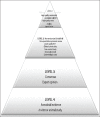Cardiovascular outcomes and safety with antidiabetic drugs
- PMID: 30202411
- PMCID: PMC6124835
Cardiovascular outcomes and safety with antidiabetic drugs
Abstract
Type 2 diabetes is a debilitating disease that impacts the life expectancy, quality of life, and health of an individual. Cardiovascular disease (CVD) is a common diabetes-associated complication and a principal cause for death in diabetic patients. This review aims to investigate and summarize the effect of Type 2 diabetes mellitus (T2DM) medications on CVD issues. A comprehensive literature review mainly from level 1 evidence was performed. Thirty-seven articles were extracted from Google Scholar, ScienceDirect, ProQuest, and PubMed Database using a combination of keywords. The findings suggest that different glucose-lowering agents have been tested for their efficacy and safety in T2DM with CVD. Some of the recent trials such as the "United Kingdom Prospective Diabetes Study," "Empagliflozin (EMPA) Cardiovascular (CV) Outcome Event Trial in T2DM Patients-Removing Excess Glucose" (EMPA-REG OUTCOME), "Liraglutide Effect and Action in Diabetes: Evaluation of CV Outcome Results," and "Trial to Evaluate CV and Other Long-term Outcomes with Semaglutide in Subjects with Type 2 Diabetes" (SUSTAIN6) have shed important light on this vital clinical concern, thus demonstrating a convincing effect of liraglutide, semaglutide, and EMPA on CVD outcomes, while metformin is thought to be the first-line optimal oral agent to manage Type 2 diabetics. Some classes of drugs demonstrate CV protection, some of them may be a result of a class effect, and some differences might be based on the population enrolled individually. Most of the trials failed to show a significant benefit with regard to mortality and morbidity in spite of intensive glycemic control. This study, therefore, enabled us to develop a guide of potential antidiabetic medication that can influence or promote CV health. Health professionals in future should weigh the CV risk against possible advantages while prescribing antidiabetic medications.
Keywords: Antidiabetic drugs; cardiovascular impact; cardiovascular risk; diabetes medications; type 2 diabetes.
Similar articles
-
Cardiovascular Protection in the Treatment of Type 2 Diabetes: A Review of Clinical Trial Results Across Drug Classes.Am J Med. 2017 Jun;130(6S):S18-S29. doi: 10.1016/j.amjmed.2017.04.008. Am J Med. 2017. PMID: 28526186 Review.
-
Cardiovascular Protection in the Treatment of Type 2 Diabetes: A Review of Clinical Trial Results Across Drug Classes.Am J Cardiol. 2017 Jul 1;120(1S):S17-S27. doi: 10.1016/j.amjcard.2017.05.015. Epub 2017 May 30. Am J Cardiol. 2017. PMID: 28606340 Review.
-
EMPA-REG and Other Cardiovascular Outcome Trials of Glucose-lowering Agents: Implications for Future Treatment Strategies in Type 2 Diabetes Mellitus.Clin Ther. 2016 Jun;38(6):1288-1298. doi: 10.1016/j.clinthera.2016.04.037. Epub 2016 May 19. Clin Ther. 2016. PMID: 27210264
-
Oral Glucose-lowering Drugs and Cardiovascular Outcomes: From the Negative RECORD and ACCORD to Neutral TECOS and Promising EMPA-REG.Curr Vasc Pharmacol. 2017;15(5):457-468. doi: 10.2174/1570161114666161208150642. Curr Vasc Pharmacol. 2017. PMID: 27928947 Review.
-
Update on Cardiovascular Effects of Older and Newer Anti-diabetic Medications.Curr Med Chem. 2018;25(13):1549-1566. doi: 10.2174/0929867324666170530075533. Curr Med Chem. 2018. PMID: 28554326 Review.
Cited by
-
Evaluation of Consistency of Treatment Response Across Regions-the LEADER Trial in Relation to the ICH E17 Guideline.Front Med (Lausanne). 2021 May 31;8:662775. doi: 10.3389/fmed.2021.662775. eCollection 2021. Front Med (Lausanne). 2021. PMID: 34136501 Free PMC article.
-
Efficacy of treatment methods for uncontrolled hypertension and its effects on atrial fibrillation: A systematic narrative review.Int J Health Sci (Qassim). 2019 Nov-Dec;13(6):39-46. Int J Health Sci (Qassim). 2019. PMID: 31745397 Free PMC article. Review.
-
Scutellariae Radix and Coptidis Rhizoma Improve Glucose and Lipid Metabolism in T2DM Rats via Regulation of the Metabolic Profiling and MAPK/PI3K/Akt Signaling Pathway.Int J Mol Sci. 2018 Nov 18;19(11):3634. doi: 10.3390/ijms19113634. Int J Mol Sci. 2018. PMID: 30453687 Free PMC article.
-
Beneficial Effects of Empagliflozin Are Mediated by Reduced Renal Inflammation and Oxidative Stress in Spontaneously Hypertensive Rats Expressing Human C-Reactive Protein.Biomedicines. 2022 Aug 24;10(9):2066. doi: 10.3390/biomedicines10092066. Biomedicines. 2022. PMID: 36140169 Free PMC article.
-
A systematic review and meta-analysis of cardiovascular diseases and associated factors among diabetes mellitus patients in Ethiopia.BMC Cardiovasc Disord. 2023 Aug 21;23(1):413. doi: 10.1186/s12872-023-03443-0. BMC Cardiovasc Disord. 2023. PMID: 37605128 Free PMC article.
References
-
- Robert AA, Al Dawish MA, Braham R, Musallam MA, Al Hayek AA, Al Kahtany NH, et al. Type 2 diabetes mellitus in saudi arabia:Major challenges and possible solutions. Curr Diabetes Rev. 2017;13:59–64. - PubMed
-
- WHO. Definition, Diagnosis and Classification of Diabetes Mellitus and its Complications. Dept. of Noncommunicable Disease Surveillance:WHO. 1999. [[Last accessed on 2017 Jul 30]]. Available from: http://www.apps.who.int/iris/bitstream/10665/66040/1/WHO_NCD_NCS_99.2.pd... .
-
- National Institute for Health and Care Excellence. Type 2 diabetes in Adults:Management of type 2 Diabetes in Adults. 2015. [[Last accessed 0n 2017 Jul 30]]. Available from: http://www.tinyurl.com/jucd4r4 .
Publication types
LinkOut - more resources
Full Text Sources

